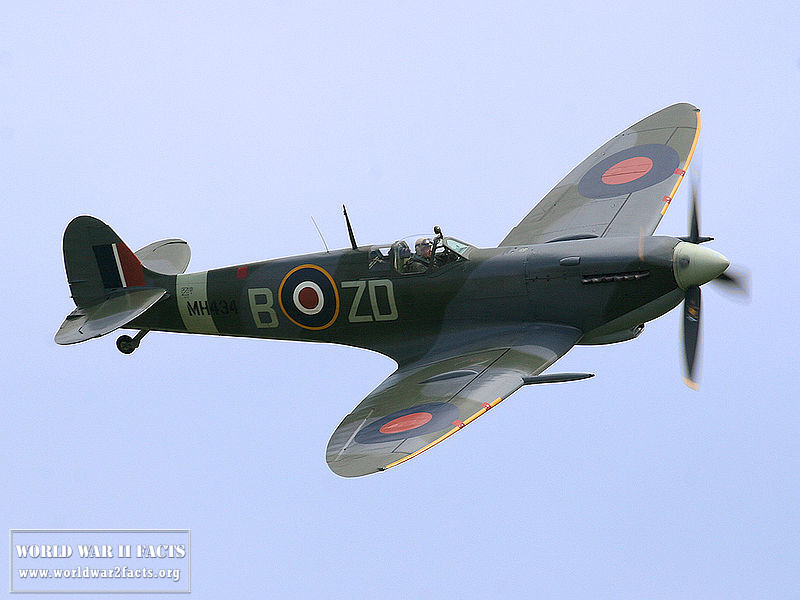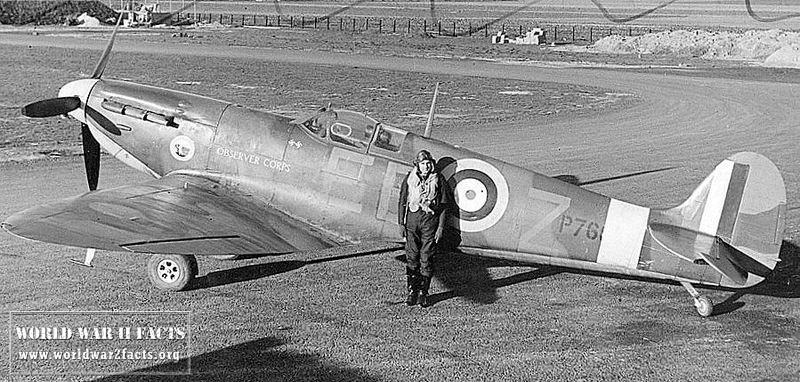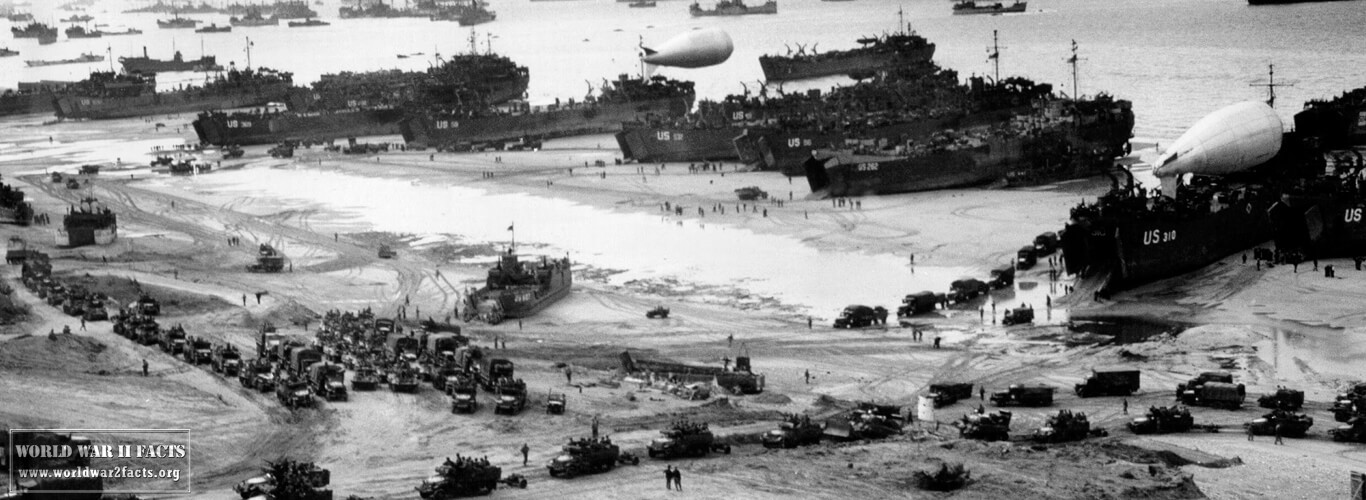British Spitfire
 British Spitfire Mk IX fighters (1943)
British Spitfire Mk IX fighters (1943)The British Spitfire is a British fighter plane used by the RAF (British Royal Air Force) and other Allied countries during World War II. It was a single-seat aircraft that continued to see action even after WWII, well into the 1950s, until it was retired for good in 1961. More Spitfires were produced than any other British aircraft.
It was also the only British plane continually produced during World War II without being superseded by a new model or aircraft design. The aircraft is also commonly referred to as the “Submarine Spitfire” depending on the World War 2 information source one comes across.
Background of British Spitfire
Contents
The British Spitfire was conceived as a short-range but high-performance interceptor. Its designer, R. J. Mitchell, worked on improving the Spitfire until he succumbed to cancer in 1937. After that, Joseph Smith continues work on the Spitfire as chief designer. One of the most important for the Spitfire was speed; thanks to its elliptical wing, it achieved higher rates than most other fighters of the time.
British Spitfire Information
- Role: Fighter / Photo-reconnaissance aircraft
- Manufacturer: Supermarine
- Designer: R. J. Mitchell
- First flight: 5 March 1936
- Introduction: 4 August 1938
- Retired: 1961 Irish Air Corps
- Primary User: Royal Air Force
- Produced: 1938–1948
- Total Aircraft Built: 20,351
- Cost Per Aircraft: £12,604
- Aircraft Variants: Supermarine Seafire, Supermarine Spiteful

British Spitfire Characteristics
The British Spitfire is one of the most iconic aircraft of the Second World War. Developed in 1936 by Supermarine, the Spitfire was designed to be a fast and maneuverable fighter with exceptional performance, even at high speeds. It quickly gained renown for its agility, speed, and accuracy in dogfights and maneuverability when carrying out low-altitude attacks on ground targets.
At its peak, the Spitfire could reach up to 430 mph speeds, powered by a Rolls Royce Merlin engine and equipped with eight .303 Browning machine guns. Its ‘elliptical wing’ design also allowed it to take turns tighter than any other aircraft from the era, making it incredibly effective in combat situations.
The Spitfire played a major role in the Battle of Britain, where it was tasked with defending British skies from Luftwaffe aircraft. Ultimately, the combination of brave pilots and agile fighters was able to defeat the German forces and ensure Allied victory in Europe.
Today, the impressive legacy of the British Spitfire lives on – its remarkable speed, innovative engineering and powerful armaments having left an indelible mark on aviation history.
- Crew: one pilot
- Length: 29 ft 11 in (9.12 m)
- Wingspan: 36 ft 10 in (11.23 m)
- Height: 11 ft 5 in (3.86 m)
- Airfoil: NACA 2209.4(tip)
- Empty weight: 5,090 lb (2,309 kg)
- Loaded weight: 6,622 lb (3,000 kg)
- Max. takeoff weight: 6,770 lb (3,071 kg)
- Powerplant: 1 × Rolls-Royce Merlin 45 supercharged V12 engine, 1,470 hp (1,096 kW) at 9,250 ft (2,820 m)
- Aircraft Performance
- Maximum speed: 378 mph, (330 kn, 605 km/h)
- Combat radius: 410 nm (470 mi, 760 km)
- Ferry range: 991 nm(1,140 mi, 1,840 km)

- Service ceiling: 35,000 ft (11,300 m)
- Rate of climb: 3,240 ft/min (16.5 m/s)
- Wing loading: 27.35 lb/ft2 (133.5 kg/m2)
- Power/mass: 0.22 hp/lb (0.36 kW/kg)
- Armament – Guns: 2 x 20mm Hispano Mk II cannon, 4 x .303 in Browning machine guns.
British Spitfire’s Role in World War 2
During the Battle of Britain, in the public’s eye, the Spitfire was the RAF fighter, despite of the many Hawker Hurricane planes that fought against the German aircraft.
After the Battle of Britain, the British Spitfire became the most critical plane in the RAF’s Fighter Command and was used extensively in Europe, the Mediterranean, the Pacific, and other theaters of war. The Spitfire served several roles and was very popular among the pilots. It was used as an interceptor, for reconnaissance, as a fighter bomber, training aircraft, and carrier-capable fighter.
One of the aircraft’s most significant contributions to the war effort was that it was used for photo reconnaissance. Because it performed so well at high altitudes, the interception was a much smaller problem. Because it was intended only as a short-range interceptor, the machine guns, and the ammunition bays had to be removed, and gas tanks were fitted there instead. Thanks to these modifications it had a high enough range to make it to Western Germany from British bases.
British Spitfire Video
What Different Versions of British Spitfire Were Built?
Many versions of the British Spitfire were built with different wing configurations. The original plane used a 768 kW (around 1,000HP) Rolls-Royce Merlin engine. It could also be equipped with more powerful engines, such as the 1,520 kW (2000HP) Rolls-Royce Griffon.
In 1943 the British Spitfire models with the Rolls-Royce Griffon engines could achieve a top speed of 440 mph (710 kph) and climb to altitudes of 40,000 feet (12km). The Spitfires were used to shoot down the German V-1s or “buzz bombs,” as they were called, which were the predecessor to the V-2 missiles. During the Second World War, Britain exported several Spitfires to countries like the USSR, Turkey, and Portugal. The U.S. forces also used them in Europe. By the time they stopped producing them, over 20,000 British Spitfires were delivered; of those 20,000, around 2000 were the Griffon versions.
Here is a table of some of the different versions of British Spitfire models:
| Spitfire Model | Year Introduced | Engine | Armament | Notes |
|---|---|---|---|---|
| Spitfire Mk I | 1938 | Rolls-Royce Merlin III | 8x .303 Browning machine guns | Initial production model |
| Spitfire Mk II | 1940 | Rolls-Royce Merlin XII | 8x .303 Browning machine guns | Improved engine, increased armament |
| Spitfire Mk V | 1941 | Rolls-Royce Merlin 45 | 8x .303 Browning machine guns or 2x 20mm Hispano cannons and 4x .303 Browning machine guns | Widely produced variant with different wing configurations |
| Spitfire Mk IX | 1942 | Rolls-Royce Merlin 61 | 2x 20mm Hispano cannons and 4x .303 Browning machine guns | Improved high-altitude performance |
| Spitfire Mk XIV | 1944 | Rolls-Royce Griffon 65 | 2x 20mm Hispano cannons and 4x .303 Browning machine guns | Increased speed and altitude performance |
| Spitfire Mk XVI | 1945 | Rolls-Royce Merlin 266 | 2x 20mm Hispano cannons and 2x .50 caliber Browning machine guns | Last Spitfire model to enter service with the RAF |
| Spitfire Mk 22 | 1945 | Rolls-Royce Griffon 85 | 4x 20mm Hispano cannons | Improved speed and altitude performance |
| Spitfire Mk 24 | 1946 | Rolls-Royce Griffon 61 | 4x 20mm Hispano cannons | Final Spitfire model produced, with improved speed and range |
Note: This is not an exhaustive list, as there were many other variants and sub-variants of the Spitfire produced throughout its service life.
The End of the Line for the Spitfire
The RAF stopped using Spitfires in the early 1950s; it was used as a photo-reconnaissance aircraft until 1954. The Spitfire was the only British plane in constant production before, during and after World War II.
British Spitfire References
- Spitfire Performance Testing, Last Viewed: 16 January 2014.
- Supermarine Spitfire – History of a legend (RAF Museum), last viewed: 17 January 2014.
- The Spitfire Site – resource library about the Supermarine Spitfire, last viewed: 17 January 2014.




